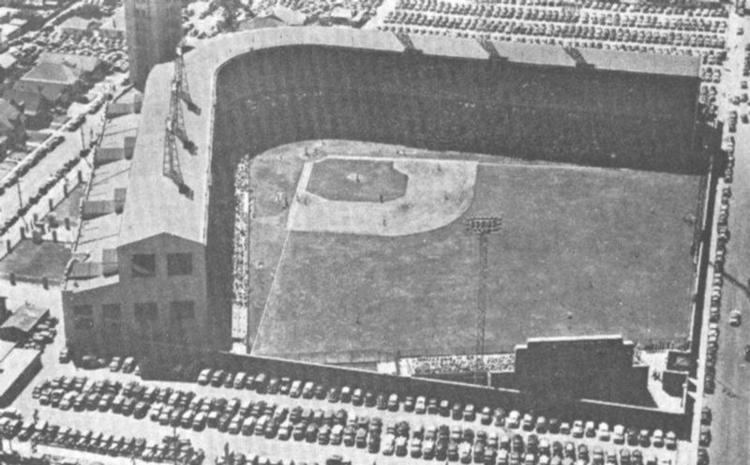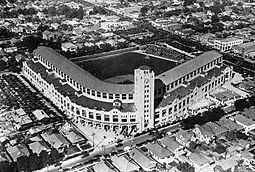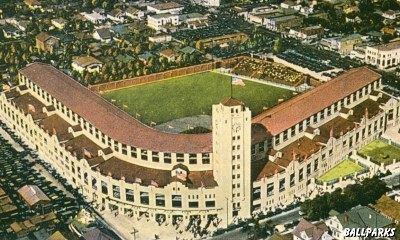Broke ground 1925 Opened 29 September 1925 | Surface Grass, Ivy Closed 1969 Demolished 1969 | |
 | ||
Field size Left Field – 340 ft (104 m)L.C. Field – 345 ft (105 m)Center Field – 412 ft (126 m)R.C. Field – 345 ft (105 m)Right Field – 339 ft (103 m)Backstop – 56 ft (17 m) Construction cost $1,500,000. A. Lanquist, Contractor. Capacity 22,000 (1925); 20,457 (1961) Similar Gil Field, Seals Stadium, Colt Stadium, Sick's Stadium, Arlington Stadium | ||
Wrigley Field was a ballpark in Los Angeles which served as host to Minor League Baseball teams in the region for over 30 years, and was the home park for the Los Angeles Angels of the Pacific Coast League as well as a current major league team, the later Los Angeles Angels, in their inaugural season, 1961. The park was designed by Zachary Taylor Davis, who had previously designed both Chicago ballparks: Comiskey Park and Wrigley Field. The ballpark was also used as the backdrop for several Hollywood films about baseball, as well as TV series such as Home Run Derby.
Contents
History

Called Wrigley's "Million Dollar Palace", Wrigley Field was built in South Los Angeles in 1925, and was named after William Wrigley Jr., the chewing gum magnate. Wrigley owned the first tenants, the original Los Angeles Angels, a Pacific Coast League team and their parent club the Chicago Cubs. In 1925, the Angels moved from their former home at Washington Park, which was also known as Chutes Park. Wrigley's Major League home (Wrigley Field) in north Chicago was named for him later, in 1927.

Wrigley Field in Los Angeles was built to resemble Spanish-style architecture and a somewhat scaled-down version of the Chicago ballpark (known then as Cubs Park) as it looked at the time. It was also the first of the two ballparks to bear Wrigley's name, as the Chicago park was named for Wrigley over a year after the L.A. park's opening. At the time, he owned Santa Catalina Island, and the Cubs were holding their spring training in that island's city of Avalon (whose ball field was located on Avalon Canyon Road and also informally known as "Wrigley Field").

Coincidentally, one of Wrigley Field's boundary streets was Avalon Boulevard (east, behind right field and a small parking lot). The other boundaries of the block were 41st Street (north, behind left field), 42nd Place (south, behind first base), and San Pedro Street (west, behind third base and a larger parking lot). Not only did L.A. Wrigley get its name first, it had more on-site parking than the Chicago version did (or does now).
Lights were added to the original park in 1930.
Minor League Baseball 1925–1957

For 33 seasons, 1925 to 1957, the park was home to the Angels, who were a farm team of the Chicago Cubs from 1921–56. For 11 seasons, (1926–1935, 1938) the park was also the home of another PCL team, the Hollywood Stars. In 1930, the Angels and Stars combined to draw over 850,000 fans, more than the two Major League teams in St. Louis (Browns and Cardinals) drew that season. The Stars eventually moved to their own new ballpark, Gilmore Field, just west of the Pan Pacific Auditorium. Angel players of note included future Dodgers Manager and Hall of Fame member Tommy Lasorda, future Phillies, Twins and Angels Manager Gene Mauch, actor Chuck Connors, Gene Baker and Andy Pafko. The parent club, Chicago Cubs were the first Major League team to play at Wrigley, when they played the Angels in a Spring training game in 1926. Years later, on March 20, 1949, The Major League Cubs played the defending World Champion Cleveland Indians in a spring training game before 24,517.

On February 21, 1957, the Dodgers bought Wrigley Field, the Angels franchise and their territorial rights for $3 million (as well as a team in Fort Worth, Texas). L.A. Wrigley's minor league baseball days then ended when the Brooklyn Dodgers of the National League transferred to Los Angeles in 1958. The Pacific Coast League Angels franchise were forced to relocate, ending up in Spokane, Washington. The use of Wrigley, and enlarging it was studied by the Dodgers. They also looked at playing in the Rose Bowl in Pasadena, California and the Los Angeles Coliseum. The Dodgers opted for seating capacity over suitability as a baseball field, and instead set up shop for four seasons in the 93,000-seat Los Angeles Memorial Coliseum (which had a 251-foot (77 m) foul line in left field) while awaiting construction of the baseball-only Dodger Stadium, which has a set capacity of 56,000. The decision to play at the Coliseum was vindicated when the Dodgers won the 1959 World Series over the Chicago White Sox, with all three games played at the Coliseum attracting over 92,000 fans including the World Series single game attendance record of 92,706 for game 5 of the series.
Major League Baseball: Los Angeles Angels
In October, 1960, Major League Baseball added two teams, expanding the American League from 8 to 10 teams. Teams were awarded to Los Angeles and Washington, D.C.. The Los Angeles franchise was awarded to Gene Autry and Bob Reynolds. The team was again called the Los Angeles Angels. In 1961 the MLB L.A. Angels began play and, by agreement, took residence at Wrigley for its inaugural season.
The agreement had been criticized, with the Dodgers playing the 1961 season at the nearby Coliseum. Wrigley Field had been considered an "abandoned minor league stadium" in a "declining neighborhood" with "terrible parking".
The Home Opener was April 27, a 4-2 loss to the Minnesota Twins before a crowd of only 11,931. Future President Richard Nixon and Casey Stengel were in attendance, along with Ford Frick, Joe Cronin and Ty Cobb.
In the last Major League game played at Wrigley, on October 1, 1961, Cleveland beat the Angels 8-5 before 9,868 fans. Steve Bilko hit the last home run in Wrigley.
The Angels set a still-standing first-season expansion-team record with 71 wins finishing 71-91. Thanks to its cozy power alleys, the park became the setting for a real-life version of Home Run Derby, setting another record by yielding 248 home runs; that 248 mark stood for over 30 years.
The 1961 Angels were led in hitting by Lee Thomas, .284; in home runs by Leon Wagner, 28 and RBI by Ken Hunt, 84. The pitching staff was led by Ken McBride with 12 wins. Future World Series winning manager Chuck Tanner played in 7 games. The team drew 603,510 fans.
In 1962, the Angels moved to the new Dodger Stadium (or "Chavez Ravine", as it was known for Angels games) for four seasons until Anaheim Stadium opened in 1966. The new Dodger Stadium also "took over" for Wrigley Field, as the site of choice for Hollywood filming that required a ballpark setting.
Professional boxing
Wrigley was used frequently for boxing. Six world title boxing bouts were held there, including the 1939 Joe Louis-Jack Roper fight. Sugar Ray Robinson also boxed at Wrigley Field. Robinson won the Middleweight Championship on May 18, 1956, knocking out of Carl Olson before 18,000 fans. On August 18, 1958, in a Heavyweight Championship fight, Floyd Patterson defeated Roy Harris with 17,000 in attendance.
1938 NFL Pro-Bowl
After the completion of the 1938 season, The first NFL Pro Bowl was held at Wrigley Field on January 13, 1939. Sammy Baugh was among those on the rosters that matched the Champion New York Giants against All-Star NFL players.
Pepperdine University
The Pepperdine Waves football team played Home games at Wrigley Field in 1948.
Soccer
On May 28, 1959, the park hosted the USA–England soccer friendly where England won 8-1 in front of 13,000 [1].
Movies and television filming
Being closer to Hollywood than the other major league baseball fields at the dawn of motion pictures, Wrigley Field was a popular place to film baseball movies. The first film known to have used Wrigley as a shooting location was 1927's Babe Comes Home, a silent film starring Babe Ruth. Some well-known movies filmed there were The Pride of the Yankees and the movie version of the stage play Damn Yankees. When Frank Capra filmed the public rally scene at Wrigley for "Meet John Doe" in August 1940, massive sprinklers simulated a downpour because the director included one rainy scene in each movie as good luck. The film noir classic Armored Car Robbery had its title heist set at Wrigley. The ballpark later found its way into television, serving as the backdrop for the Home Run Derby series in 1960, a popular show filmed in 1959 which featured one-on-one contests between baseball's top home run hitters, which had a revival in 1989 when it aired on ESPN, and later on ESPN Classic. Episodes of shows as diverse as The Twilight Zone ("The Mighty Casey", 1960), Mannix ("To Catch a Rabbit", 1969) and The Munsters ("Herman the Rookie", 1965) were also filmed there. Some closeups were filmed there for insertion into the 1951 film Angels in the Outfield, a film otherwise set at Forbes Field in Pittsburgh. A 1932 movie short starring Babe Ruth titled Just Pals was also filmed at Wrigley Field.
Demolition
Following the Angels' departure, there were no regular tenants at Wrigley Field after 1961. By then the park was owned by the city, and various events were staged. On May 26, 1963, a large crowd attended a civil rights rally featuring Martin Luther King, Jr. By 1966 the park was being used for soccer matches and the like.
In October 1968, the ballpark was renamed Gilbert Lindsay Community Center as a first step in renovating the site. Demolition was under way by January 1969. The resulting city park has a ball field in the northwest corner of the property, which was once a parking area. The diamond is locally known as "Wrigley Field", and is the home of Wrigley Little League baseball and softball. The original site of the Wrigley diamond and grandstand is occupied by the Kedren Community Mental Health Center and another parking lot.
Dimensions
The ballpark's dimensions were cozy but symmetrical, giving a nearly equal chance to right and left-handed batters in the Home Run Derby series. The only difference was that the left field wall was 14.5 feet (4.4 m) high, whereas the right field fence was only 9 feet (2.7 m) high.
